#vogue 1793
Photo



Calvin or Claire? Vogue 1793 from 1996
The question comes from my recent spotting of a very similar draped neckline in an image of Claire McCardell from the 1950s; she was an American designer who died far too young. I like this neckline because it has the crossing of the fronts above the bust which means it neither catches the bust nor droops down too low at the neckline as many surplice or wrapped bodices can do.
True, from what I can tell McCardell’s neckline seems to have been a raised neck in the back which is easier to sew, while Klein’s acts like a shawl collar, that is, the front bodice has an slender piece which extends around the neck to meet in the back. Which is an improvement to my eye because I find it fits the neck better.
And McCardell’s dress had set-in sleeves while Klein’s are dolman. Which is not an improvement to me, as it takes up LOTS of fabric, especially when you use a fabric with nap which I did with this velour. This pattern would take up much less fabric done in a fabric without nap as you could place the pieces far more closely together. McCardell did use dolman sleeves often, especially when she was placing a cotton plaid on the bias which she liked to do. You can see how dolman sleeves would make life much easier as the matching of the plaid was then limited.
And another difference was Klein used giant shoulder pads as this dress does. Women’s wear sported giant shoulder pads starting in the late 1980s and it continued into the 1990s. It was an era when women were moving into corporate leadership and apparently we all thought we would look more formidable if we dressed like linebackers. ;-)
In any case, it makes for a very nice dress and I have made it multiple times without the shoulder pads, and without the center back zipper by always using knits which makes it easy to pull on. I added a godet to long slit at the back hem.
And then I decided to make it as a top as you can see. This palomino velour had been stuck in a box for far too long which explains the creases which should come out with the first garment washing. If you have never worked with cotton-blend velour, it is medium weight fabric, has a nap, and is soft. The nap makes you want to stroke it and also means it catches the light in subtle ways.
#1990s fashion#sewing#dressmaking#calvin klein#Claire mccardell#sewing patterns#vintage sewing patterns#vogue 1793#vogue sewing patterns#vogue patterns#1980s fashions#women's fashion#costume history#dress history#fashion history#making#makers#altering a pattern#hacking a pattern#cotton velour#fashion fabrics#fabrics with nap#sewing with nap#dolman sleeves#shoulder pads#surplice bodice#garment design#vintage garment design#history of garment design
6 notes
·
View notes
Text
La collégiale Saint-Vulfran, Abbeville, Somme (80)
De passage à Abbeville le 30 mai 2012, mon temps est compté dans cette petite ville aux portes de la Baie de Somme. Je me contente donc de prendre le temps de visiter la collégiale de Saint-Vulfran. Je ne le regrette pas : quel édifice ! C’est le joyau gothique de la cité, qui appartient aujourd’hui à la commune.

Façade de la collégiale Saint-Vulfran
Les origines de la collégiale sont à aller chercher au XIe siècle, lorsque les reliques de Saint-Vulfran furent rapportées par le comte de Ponthieu à Abbeville, qui était alors leur capitale. La construction de l’édifice actuel débuta en 1488 après qu’on eut assécher les fonds marécageux. Façade et nef sont d'abord construites dans le style gothique flamboyant alors en vogue à cette époque. La finesse de la rose, les deux tours symétriques surmontées à cinquante-cinq mètres de haut de tours de guet, la richesse des décorations et des sculptures qui ornent les trois portails témoignent de la richesse et de la prospérité d’Abbeville au XVe siècle.

Père Céleste présente au Monde son fils crucifié
La première messe est célébrée dans une chapelle latérale en 1524 mais par manque de fonds, le chantier s'interrompit en 1539 alors que l'église n'a pas de chœur. La construction ne reprit que plus de cent vingt ans plus tard, en 1661 et le chœur s'éleva enfin. En 1663, Saint-Vulfran est enfin achevée, ou presque. Car aujourd’hui, la partie qui semble être détruite est en réalité le début d’un chantier qui resta inachevé faute de fonds suffisant pour être mené à bien.

Partie inachevée
En 1793, l'église devient temple de la Vérité et de la Raison. Après le Concordat, le culte catholique y est rétabli. En 1840, le bâtiment est inclus dans les premières listes des monuments historiques.
En mai 1940, sous les bombes allemandes, un incendie noie la ville et détruit la collégiale. Seules les tours et la façade subsistent ainsi que le début de la nef. La voûte s'est effondrée. La restauration ne prendra fin qu'en 1998.

Les voûtes impressionnantes de la nef
L’impression de hauteur qui se dégage de l’édifice est frappante dès l’instant où l’on y pénètre. En effet, la hauteur sous voûte est de trente-et-un mètres alors que la largeur n’est que de trente-sept mètres. Cette impression est renforcée par l’absence de chapiteaux sur les colonnes ainsi que par les deux rangées de vitraux aux teintes bleutées de William EINTEN.

Le chœur et l'abside de la collégiale Saint-Vulfran, son maître-autel de 1848 et les vitraux de William Einstein.
Vous voulez en découvrir plus ? Les autres photos prisent à l'occasion de mon passage sont dans un album Flickr
Et pour voir encore plus de photos de l'intérieur et de l'extérieur de tout un tas de détails à côté desquels je suis passée ce jour-là, le site de Patrimoine Histoire est une mine d'informations !
Cet article a été écrit originellement pour mon précédent blog (supprimé) en 2013.
#France#Somme#HautsdeFrance#Picardie#Abbeville#Patrimoine#Eglise#Collégiale#SaintVulfran#SaintWulfran
0 notes
Text
I had a very silly idea...
What if I design a fake 1793 Vogue magazine edition. It has fashion from the time, gossip and thirsty articles about cps members
68 notes
·
View notes
Text
Le Parc Monceau
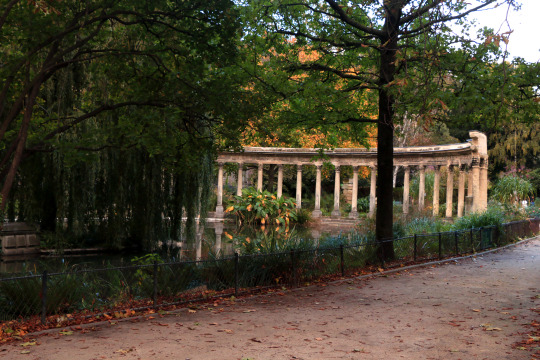
Ce poumon vert du VIIIème arrondissement, bordé par le très chic boulevard de Courcelles formant frontière avec le XVIIème, est entouré de riches hôtels particuliers du XIXème et de luxueux immeubles haussmanniens. Surplombant un centre de formation de la RATP (au sein de l'ancien terminus en boucle de la ligne 3), il offre aux joggers une autre boucle d'un kilomètre tout pile (en évitant l'aire de jeux de son coin nord-ouest), il propose aux enfants bourgeois du quartier un carrousel, des balançoires (chantées par Yves Duteil) et des balades à poney, tout en affichant aux promeneurs un dépaysement certain, de par ses nombreux aménagements et fabriques de jardins héritées de son original passé.
Monceau n'est point vallonné (comme sa toponymie pourrait nous le laisser croire) mais bien plat, la plaine de Monceau étant une altération du nom du précédent village de Mousseau. Le duc de Chartres, Louis-Philippe d'Orléans (futur Philippe-Egalité à la Révolution et père de Louis-Philippe, dernier roi des français sous la Monarchie de Juillet), acquiert en 1769 un vaste terrain sur cette plaine, alors située en dehors de Paris, afin d'y établir une "folie", selon la mode alors en vogue (cf. article sur l'Hôtel Salomon de Rothschild décrivant la "Folie Beaujon"). Il fait édifier par l'architecte Louis-Marie Colignon un large pavillon octogonal à deux étages, que l'on nommera par la suite la "Folie de Chartres", entourée d'un vaste jardin à la française. Le duc charge dans les années 1770 le paysagiste écossais Thomas Blaikie de transformer ses jardins dans le style anglo-chinois, et le peintre et décorateur Louis Carrogis de Carmontelle de l'agrémenter de nombreuses fabriques ornementales de styles divers et variés, alliant exotisme et romantisme. On y trouve alors une fermette suisse et un moulin hollandais, une pagode chinoise et de fausses ruines médiévales, un minaret orientalisant, des pastiches de vestiges de colonnes travestissant la Grèce antique, un temple en marbre blanc dédié à Mars (dieu romain de la guerre), transformé sous la Restauration monarchique en "Temple de l'Amour" et déplacé au bout de l'Ile de la Jatte à Neuilly-sur-Seine, où il se trouve toujours... Subsistent de nos jours au Parc Monceau un faux sarcophage, un obélisque et une pyramide inspirés de l'Egypte ancienne, symboles maçonniques s'ils en sont, le duc de Chartres étant franc-maçon et grand-maître d'une loge créée à son instigation, sa pyramide abritant alors une statue de la déesse Isis (représentation absolue du culte de la déesse), et son pavillon ayant servi -paraît-il- à de nombreuses initiations... La "naumachie", bassin dédié aux reproductions de batailles navales à échelle réduite sous l'Empire romain, a également été préservée. Entourée d'une colonnade semi-circulaire dotée de chapiteaux corinthiens érodés par le temps, avec entablement (visible ci-dessus), il s'agit de fait du seul "vestige" archéologique avéré, trouvant son origine dans l'architecture de la Rotonde des Valois, vaste chapelle circulaire latérale attenante à la Basilique de Saint-Denis, voulue par la reine Catherine de Médicis en 1559, afin d'accueillir le monument funéraire de son défunt royal époux Henri II, puis de toute la dynastie des Valois à sa suite... Projet qui n'aboutit finalement jamais, les Bourbons succédant aux Valois, la Rotonde fût délaissée, abandonnée, puis finalement détruite en 1719. Carmontelle récupéra alors ces éléments architecturaux la composant (grand bien lui fit!) Le duc, s'engouffrant par la suite dans les affres de la Révolution, changeant son patronyme en Philippe-Egalité, votant pour la mort de son cousin Louis XVI (!), ne put toutefois pas échapper à la guillotine, le décollant en novembre 1793. Ses jardins et sa folie deviennent alors propriété de la ville de Paris, nouveau lieu de fêtes publiques accueillant excès en tous genres et exploits sportifs, comme ce premier saut en parachute de l'histoire, exécuté en 1797 par l'aérostier André-Jacques garnerin, sautant de sa montgolfière à plus de 1000 mètres d'altitude et se posant en douceur au coeur du parc! Lequel parc est restitué en 1802 à la famille d'Orléans, qui fait démolir l'ancienne folie. Napoléon III (par le truchement de son sbire parisien le baron Haussmann) exproprie de nouveau les Orléans en 1860, réduisant le parc de 18 à 8,4 hectares, permettant le percement du boulevard Malesherbes et le lotissement du nouveau quartier de la plaine Monceau, accueillant par la suite la haute bourgeoisie d'affaires du Second Empire. De cette époque datent les luxueuses allées semi-privées bordées de somptueux hôtels particuliers, propriétés de grands noms de la finance et de l'industrie, tels que les frères Pereire, le chocolatier Menier, Cernuschi (article précédent), Camondo (article à venir)... Chacun ayant sa propre grille d'entrée privative menant au nouveau Parc Monceau. L'architecte Gabriel Davioud le ceinture de monumentales grilles en fer forgé, surmontées de candélabres, tandis que l'ingénieur Adolphe Alphand y crée une rivière artificielle enjambée par un pont devenu iconique, ainsi qu'un monticule surmonté d'une cascade, abritant une grotte arborant les premières stalactites en ciment artificiel. Le Parc Monceau devient donc un laboratoire de création préfigurant les aménagements paysagers parisiens à venir des parcs Montsouris et des Buttes-Chaumont, ainsi que ceux des Bois de Boulogne et de Vincennes.

La répression de l'insurrection de la Commune de Paris ayant déclenché l'incendie de nombreux monuments parisiens, dont son Hôtel de Ville, une arcade encadrant l'un de ses deux porches d'entrée, sauvée des flammes, trouva sous la IIIème République naissante son gîte final en surplomb d'une allée du Parc Monceau, apportant un deuxième vestige de la Renaissance française (l'ancien hôtel de ville de Paris, du ciseau de l'architecte italien Boccador, datait en effet du XVIème siècle). A la Belle Époque, plusieurs monuments statuaires furent érigés sporadiquement sur les pelouses du parc, glorification post-mortem des artistes résidents voisins, promeneurs célèbres de Monceau, de Chopin à Gounod, de Musset à Maupassant... Dernière adjonction monumentale en date, la lanterne japonaise 'toro', datant de 1786, don du Japon à la France en 1982, symbole d'un pacte d'amitié entre Tokyo et Paris, sous le mandat de son maire d'alors Jacques Chirac, fervent défenseur de la culture nippone, trouvant ainsi un écrin historiquement emprunt d'exotisme, qui plus est à deux pas du Musée Cernuschi, dévolu aux arts asiatiques. Mentionnons encore son patrimoine végétal, riche de nombreux arbustes et arbres remarquables, dont un splendide gingko biloba daté de 1879, ainsi qu’un exceptionnel platane d’orient, planté ici en 1814, atteignant aujourd’hui 31 mètres de hauteur pour un tronc d’une circonférence à sa base de près de 7m, ce qui fait de lui l’arbre le plus gros de Paris.
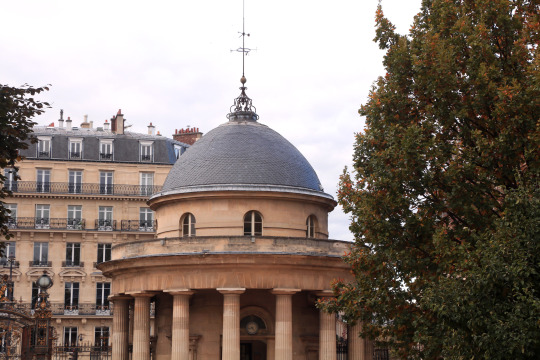
L'entrée principale du Parc Monceau (tout proche de la station de métro éponyme) consiste en deux grilles de part et d'autre d'une rotonde (dite "de Chartres", en mémoire de l'ancienne folie du duc de Chartres), surmontée d'un dôme, surmonté d'une girouette, surmonté d'un paratonnerre. Il s'agit d'un monument, datant également de 1786, ancien pavillon d'octroi d'une enceinte de Paris élevée à la fin du XVIIIème siècle, le Mur des Fermiers Généraux. Ponctué de soixante barrières, comme autant de portes d'entrées dans Paris, chacune était sous le patronage d'un pavillon abritant les bureaux des services chargés de collecter l'octroi, taxe sur les denrées entrant et sortant de la capitale, hautement impopulaire à l'époque (d'ailleurs l'une des causes d'agitations populaires ayant conduit à la Révolution). Elevés par l'architecte Claude-Nicolas Ledoux, dans un style néoclassique monumental contrastant avec la fonction première des bâtiments, il n'en reste plus que quatre aujourd'hui, dont celui-ci, ayant pour particularité de ne pas consister en une barrière à proprement parler, car aucune marchandise n'entrait ni ne sortait alors par la barrière de Chartres, emprise sur la folie du futur duc "Egalité", celui-ci ayant demandé à Ledoux une "galanterie" architecturale lui permettant l'accès à une plate-forme d'observation de ses jardins... Cette monumentale rotonde accueille aujourd'hui la loge des gardiens du Parc, ainsi que des commodités publiques... Ou comment les monuments se transforment au fil du temps...
#parc#Monceau#parc Monceau#monument#folie#duc de chartres#pavillon d'octroi#rotonde#colonnade#barrière#entrée#promenade#arbres#ruines#patrimoine#histoire#architecture#paysage#culture#vestiges#saut en parachute#Paris#8ème#chic#photography#photo#photooftheday#Second Empire#Revolution#Renaissance
9 notes
·
View notes
Photo

A young lady reaching for a guitar at a stone casement and a boy playing the flute beyond by Martin Drolling
This ambitious canvas, seemingly unrecorded in recent literature is an important new addition to the oeuvre of Martin Drolling, a contemporary of Louis Leopold Boilly and author of the remarkable Interior of a kitchen (Louvre, Paris). Its impressive scale and refinement of finish allow one to identify it with the picture of the same subject listed among Drolling's four Salon entries for 1798. It is dated 'an 5', as 1797 was termed during the revolutionary years, which would be consistent with a picture exhibited at the Salon in 1798 given that there was no Salon the year this picture was actually painted.
Born near Colmar on the Prussian border of France, Drolling moved to Paris in 1780 and almost immediately started exhibiting, first at the Salon de la Correspondance in 1781 and during the revolutionary years, when the academic restrictions were lifted, at the Salon du Louvre, beginning in 1793. Drolling excelled at portraiture as well as genre painting and was drawn to the then popular 'Dutch' style whose characteristics included a love of trompe-l'oeil effects and a taste for sentimental genre subject matter. He formed part of a circle of like-minded artists of whom Boilly is now the best known who were immortalized in Boilly's great La réunion d'artistes dans l'atelier d'Isabey painted the year after this canvas, in 1798. Drolling featured in that painting and such was Boilly's admiration for Drolling's work that he made copies after two later compositions.
There was during the reign of Louis XVI a fascination for Dutch seventeenth-century masters which was widely shared by the collecting class, among them Randon de Boisset, the baron de Besenval and comte de Merle. This taste for the northern masters remained in vogue after the Fall of the Bastille, fuelled in part by the efforts of the dealer, painter and husband of Vigée, Jean-Baptiste Pierre Le Brun, who dealt in northern paintings and popularized them through his publication of the highly influential volumes of engravings after northern paintings in private collections, La Galerie des Peintres Flamands, Hollandais et Allemands, in 1792. Singled out for particular praise were the 'finschilderei' such as Gerrit Dou of whom he wrote, 'in his genre he must be seen as the most perfect and the most accomplished painter whom Holland has produced' and Van Mieris, 'his works are of such perfection, that one thinks one is looking at nature through a window'; Metsu also was regarded as a great master, 'without neglecting the true and precious details of nature he made for himself a grand and easy manner'.
It was in this climate that Drolling produced, in the 1790s, a series of highly finished genre paintings that owe such an evident debt to compositions by Gerrit Dou and Frans van Mieris. Of them this example is by far the largest, perhaps indicating the artist's intention to make an impression at the Salon of 1798. This comparatively small group of highly wrought paintings painted includes Donnant La Liberté (which shows a young woman releasing a caged bird while a young boy holding a violin looks on) and Painting and Music: portrait of the artist's son (Los Angeles, Los Angeles County Museum of Art). In all cases there is a play on the conceit of music in painting; we view the protagonists framed in a fictive window; a Turkey rug is thrown over the sill and it, as well as the other still life elements, are painted with particular attention to detail. All three are clearly intended as homages to his seventeenth-century Dutch predecessors whose genre scenes had been so highly prized.
8 notes
·
View notes
Link
In each century, their clothing reflects the period while maintaining their sartorial preferences. Robes, armor, and suits don't look similar; nevertheless, costume designer Claire Anderson has found a through line keeping several things consistent including the color palette and the details (which the devil is in, of course).
Variations on sunglasses do date back to the Romans, with Emperor Nero favoring emerald lenses for gladiator fight spectating. Crowley starts wearing eyewear in this period to hide his serpentine eyes; however, as with the rest of his look, he doesn’t just stick with the first pair he lands on. In Rome, he opts for tiny sunglasses that would fit right in with Keanu in The Matrix, but they barely conceal his origin as the snake in the Garden of Eden.
As Crawley — he changed his name to Crowley — the serpent, he had a black body with a red underbelly, which informs his entire closet no matter the time period. The flash of scarlet is as subtle as the lining of his jacket collar or the soles of his shoes (maybe he influenced Christian Louboutin?). Snake imagery includes the hilt of his walking stick in Victorian London, a snakehead belt, snakeskin shoes, and clothing texture to match the scales of his former body. He even has a serpent tattoo sideburn. It is lucky for Crowley that snakes have influenced fashion through many different centuries.
Angel inspiration that is also understated isn't an easy task, but Aziraphale manages to forgo the obvious all-white look. In 537 AD his fur-covered shoulders are wing-adjacent, but it is his top hat in St James’s Park in 1862 that looks the most wing-like with its feathered effect. Crowley’s most flamboyant look is probably his Elizabethan frills, which speak to his love of neckwear. During the French Revolution in 1793, he barely keeps his head because he can’t bear to alter his clothing standards to blend in. However, this is the one occasion in which Aziraphale embraces bold color in his wardrobe after Crowley shows up to save his ass.
The Victorian era is truly when Aziraphale comes into his own; other than his neckwear and hat, his costume pretty much stays the same from this moment on. His tartan tie evolves from super flamboyant to a cravat before settling on the bowtie in the present. This pattern comes into play in the finale — "Tartan's stylish" — showing Aziraphale’s taste shines through no matter the situation. Red is Crowley’s link back to his former life, while Aziraphale has gold stitching and a pocket watch as a nod to his ethereal self (and to the flaming sword he gave away).
In the second episode, Aziraphale is aghast when a paintball hits the back of the coat he has kept in “tip-top condition for over 180 years.” If he miracled it away, he would know the stain was always there, despite appearances. Once again, Crowley makes things better by ridding the coat of the ink, restoring his outerwear to its tip-top state. Both take very different approaches to how they dress, but their clothing clearly matters to them — and like any good couple (platonic or otherwise), they complement each other.
Crowley’s signature, almost goggle-like glasses are introduced in the 1800s — the Victorian period had a big impact on both — although they will change in style into the next century. In the ‘60s, Crowley has a whole Beatles vibe going on, but in the present day, his style is more Rolling Stones. Both angel and demon are somewhat stuck in their sartorial ways, which only adds to the stylized nature of Good Omens. Most of Crowley's costumes are custom builds in-house, but he does wear a Balenciaga cropped jacket in the first episode. There is also something very Saint Laurent about Crowley’s look, whereas there are no designers currently working with styles to match Aziraphale. This is professor chic, not from the pages of Vogue.
For a truly decadent timeless vibe, look no further than Jon Hamm as the angel Gabriel. He has no time for Aziraphale’s BS and he is impeccably turned out, no matter the occasion. Costume designer Claire Anderson told SYFY that Gabriel’s suits are courtesy Zegna and even his running attire is cashmere as this material, “just floats around you. It sits where it touches. It's delicious to wear. It feels sensational. And it just drips off of him."
Saving the world is hard work, but after 6,000 years on Earth, Aziraphale and Crowley don't have to worry about finding their fashion groove.
622 notes
·
View notes
Photo

Everything You Should Know About Anarchism
Writer Kim Kelly is an anarchist based in New York City and an organizer with the Metropolitan Anarchist Coordinating Council (MACC).
In a pop-cultural sense, at least, the idea of anarchy has been characterized by either a middle-fingers-up, no-parents-no-rules punk attitude, or a panicky, more conservative outlook used by national and state sources to represent violent chaos and disorder. Today, we can see an extremely serious, radical leftist political philosophy on T-shirts at Hot Topic.
So what is anarchism? What do those people raising black flags and circling A’sreally want? Here’s what you need to know:
What is anarchism?
Anarchism is a radical, revolutionary leftist political philosophy that advocates for the abolition of government, hierarchy, and all other unequal systems of power. It seeks to replace what its proponents view as inherently oppressive institutions — like a capitalist society or the prison industrial complex — with nonhierarchical, horizontal structures powered by voluntary associations between people. Anarchists organize around a key set of principles, including horizontalism, mutual aid, autonomy, solidarity, direct action, and direct democracy, a form of democracy in which the people make decisions themselves via consensus (as opposed to representative democracy, of which the United States government is an example).
“I would define anarchism as the nonhierarchical, nonelectoral, direct-action-oriented form of revolutionary socialism,” Mark Bray, a lecturer at Dartmouth College and author of Antifa: The Anti-Fascist Handbook, tells Teen Vogue.
As the New York City-based anarchist group Metropolitan Anarchist Coordinating Council (MACC), of which I’m a member, writes on its website it, “We demonstrate a vision for a society in fundamental opposition to the brutal logic of contemporary capitalism — a society based on mutual aid, cooperation, and radical democracy.”
Where did anarchism come from?
Anarchism has ancient roots, with the word itself stemming from the ancient Greek anarchos, or "without rulers," but it fully bloomed as a political philosophy in Europe and the United States during the 19th century. At the time, Communist thinker Karl Marx’s writings had become popular, and people were searching for alternatives to the capitalist system. The Paris Commune — a brief period in 1871 when Paris was controlled by anarchists and communists — helped spread the message of anarchism further, and inspired more young radicals to take up the cause, sometimes to violent effect when they embraced the philosophy of “propaganda by the deed.” By the early 20th century, anarchism had spread throughout the world, but government repression often made it difficult for anarchists to organize and achieve their goals.
Pierre-Joseph Proudhon is generally recognized as the first self-proclaimed anarchist, and his theories continue to influence anarchist thought today — if you’ve ever heard the phrase “property is theft,” that’s straight from Proudhon’s 1840 book What Is Property? But Proudhon was far from the only prominent thinker to advance the cause of anarchy. William Godwin’s 1793 treatise, An Enquiry Concerning Political Justice, is hailed as a classic of antistate, proto-anarchist thought. Other famous contributors to anarchism’s development include Peter Kropotkin, Mikhail Bakunin, Emma Goldman, Lucy Parsons, Voltairine De Cleyre, Max Stirner, Johann Most, Buenaventura Durruti, and Alexander Berkman. In addition to these names, countless others, whose identities have been lost to history, have helped refine and spread the ideology of anarchism. Today, anarchism is a fully global, intersectional philosophy, with particularly strong roots in Latin America, Spain, Germany, and, as of 2012, the Middle East, due to the 2012 Rojava Revolution in occupied Kurdistan.
Continue reading
📸: Getty Images
739 notes
·
View notes
Quote
MRS R-SSELL, NO. 17, FLUDGER STREET, WESTMINSTER
is a fine plump girl, at the age of twenty eight, rather dark hair and eyes, she keeps a house and sometimes sports a chariot. This lady has been some years in the service in London, where she was much in vogue with the bucks and bloods of the town, who admired her more for her vulgarity than anything else, she being extremely expert at uncommon oaths, and, at her first commencing a lady of pleasure, she threw of all restraint, so that her modesty was never offended to reveal all the secrets, which the delicate part of the sex think proper to conceal, brought her a number of clients among the youth, who are fond of beholding that mouth of the devil from whence all corruption issueth. These she took care to fleece sufficiently; so that by her economy, she is now enabled to keep her country house and receives visits from only a few, and has in some degree left off her habit of swearing.
This lady being a very good pen-woman, and much out of town, has a good opportunity of displaying her talents in that line to her lovers.
Harris’s List of Covent Garden Ladies OR, Man of Pleasure’s Calendar for the Year 1793
22 notes
·
View notes
Photo

Reading Boy (1758). Per Krafft the Elder (Swedish, 1724-1793). Oil on canvas. Nationalmuseum - Stockholm.
In 1755 Krafft traveled to Paris, where he became a student of Chardin. He later became a student of Alexander Roslin, a professor at Bayreuth and court painter to Stanisław August Poniatowski of Poland. Krafft paintings in Paris included portraits and some genre portraits, for example Reading Boy (1758). In such images, he followed Jean-Baptiste Greuze's style, which was in vogue at the time.
51 notes
·
View notes
Text
WHITE SHIRTS PROJECT - RESEARCH (2)
It made its first public appearance at the Salon in Paris, worn by a queen in a portrait: Marie Antoinette in a muslin dress. A style and a portrait - by Madame Vigée-Lebrun - far from the royal etiquette: in 1793 it caused a scandal.
In the 19th century it was embellished by bouffant details, and by the end of the century it became a symbol of wealth, since it was worn by those who didn’t work, so they couldn’t stain its whiteness.
In the Forties it became a trend thanks to the stars of Hollywood: in 1938 Katharine Hepburn wore it in Holiday; Ava Gardner wore a short-sleeved model with wide shorts and lipstick, followed by Lauren Bacall in Key Largo in 1948: white shirt and ice-cold look.
In the Fifties it took Audrey Hepburn to make the shirt with rolled sleeves and lifted collar iconic: she was a princess hanging around with Gregory Peck, those were her Roman Holidays.
In those years, femininity was particularly under the spotlight. The pin up style was trendy - shorts and curves, the shirt often tied up to emphasize the decolletage, the bust peeking through. The same happened in the Sixties, but the white shirt was turning into an androgynous piece, an unaware feminist manifesto. In a 1967 shot, Twiggy wore a pinstriped suit, a white shirt and tie.
Among all the pictures showing the history of the white shirt, Robert Mapplethorpe’s black and white portrait of Patti Smith, the cover of her first album, Horses, is legendary: Patti became an androgynous icon, the album a best seller, the white shirt - in this masculine version - a must-have.
So in the Seventies, even Marlene Dietrich and Katharine Hepburn gave their personal interpretations of the androgynous appeal of white cotton.
In the Eighties, it was paired to Ray-Bans and black jacket à la Blues Brothers; it was also revived with a retro-rock vibe by Prince, who wore white shirts with ruffled jabots. In 1986 a masculine-yet-sexy version appeared, thanks to Kim Basinger in Nine ½ Weeks. In 1987, another movie, Dirty Dancing, re-launched the trend of the tied-up white shirt: many girls copied the protagonist, Frances “Baby” Houseman.
Nineties. The oversized shirt worn by Julia Roberts in Pretty Woman, and in 1994 a shirt as stylish as its wearer, Uma Thurman, was paired to cigarette pants and ballerina flats in Pulp Fiction. The point of view progressively became anarchic: all the nine top models on the 100th anniversary cover of Vogue US wore the same GAP shirt.
In 2003 an oversized shirt was seen on Gwyneth Paltrow, who hastily put that shirt only on, before running from a hotel room and getting herself a drink (it was a Martini commercial). Many other celebrities sported it in any occasion, in different outfits - Katie Holmes, Jennifer Aniston, Eva Mendes, Cameron Diaz, Kate Hudson and Gwen Stefani.
In fashion.
One of the first ground-breaking moments was in the Twenties. Coco Chanel turned the world of fashion (ruled by corsets) upside down by introducing a masculine style: thanks to her, women started wearing pants, loose white shirt and cardigan, an extremely contemporary outfit.
Seventies: in that decade, dominated by an ethnic mood, the white shirt was loose, a bit long and flared, with white collar, wide sleeves and gathered cuffs. Flowy shirts, with feminine couture echoes, were designed by Rykiel, Guy Laroche, Nina Ricci and Saint Laurent.
Eighties: the decade was opened by a parade of white shirts in Vivienne Westwood's Pirate collection in 1981. Symbols of those years were the white shirts by Ferré, architectures with big collars and cuffs, rich in historic references, made in different fabrics and shapes, always featuring a dramatic structure.
Career women wore a white shirt with a skirt suit; the same outfit screamed "lady of the night" when the masculine fabric was replaced by black leather. As an alternative, jabots, puffy sleeves and retro hints could be found in the teddy boy style, an Edwardian-meet-gangster mood: the result was rockabilly, as many rockstar outfits showed.
Nineties. Artists, creative and communication experts took the white shirt as a paradigm of minimalism, manifesto of the trend which simplified, cleaned and reduced, an exhausted reaction to the exaggerations of the previous decade.
Many designers brought this approach on runways and in closets: the conceptual style of Martin Margiela, the over-experimentalism of Junya Watanabe, the American minimal, democratic and pragmatic school of Calvin Klein and Donna Karan, the British reply of Burberry and Prada, which set a trend all over the world.
In addition to that, in the Noughties came the monastic style of Raf Simons for Jil Sander, the classic Hermès shirt revisited by Gaultier, the eco-friendly and avant-garde attitude of Stella McCartney, Celine's purism by Phoebe Philo.
The latest shows have brought the white shirt under the spotlight in different ways.
A delicate world dressed white angels with Alberta Ferrettishirts; Herrera gave a dynamic, simple and chic version of white. Valli emphasized this color: the button-down shirt was paired to a tight bandage. Donna Karan embellished a plunging neckline with wide jabots, while Martin Margielaadded a statement accessory to a buttonless shirt with boat neckline: a sort of tie clip, made of metal, to hold rolled sleeves.
While referring to the tradition of the white shirt, Pilatidesigned a very classic one, but without collar: the matching PVC mantle had to be worn with a crewneck shirt. Marc Jacobs and Lam, probably drawing inspiration from the Far East, used Mao collars and dared to add just a hinted neckline. Almost mystic, the all-white by Dries Van Noten gave glimpses of the fragile elegance of the shirt, inspired to glass paste or a vintage crystal. Last but not least, Hermès: the shirt became a minidress, accented by a thin belt. The unique touch? A bow tie, of course.
To conclude, there's nothing like a white shirt to show the character of the one who wears it.
https://www.vogue.it/en/magazine/editor-s-blog/2011/08/august-10th#ad-image110564
0 notes
Text
A view from the A270
Seeking refuge along the Lewes Road in Brighton & Hove’s forgotten suburbs

At its source, the A270 divides the affluent Hanover area with its crescents, private roads and estate agents from ‘The Level’, the preferred daytime refuge for many of the city’s heterogenous groups. The socio-economic divide that plagues Brighton & Hove is encapsulated topographically here. This series of photos explores the in-between spaces or heterotopia that mark the arterial drag that is the Lewes Road. I wondered what spaces of refuge or evidence of local community exist along the way? As a former Sussex postgrad (MA Digital Documentary) I rarely ventured beyond the Falmer campus, instead heading in the opposite direction towards home in Kent. Nevertheless, the Lewes Road area is home to a sizeable proportion of Brighton & Hove’s student population. Many of my fellow students lived here but have since moved on.

Unusually, the A270 begins as two separate one-way streets, a fork created by ‘The Level’ which merges into two-way traffic at the Vogue gyratory. Named after the former Vogue Cinema which was replaced by a Sainsbury’s supermarket in 1985, the Vogue was an X-rated film and strip club in the 1970s. Even today, iconic Brighton & Hove landmarks such as the pier, the Royal Pavilion, The Dome, Victoria Gardens couldn’t seem further away amidst the endless commuter traffic of the gyratory. The A270 then snakes its way north-eastwards to the neighbouring town of Lewes via the sprawling suburbs of Bevendean, Moulescoomb, Coldean and the Falmer campuses of Brighton and Sussex universities.

This series of 27 sequential images therefore reflects the A270 that inspired them; images are displayed as they were captured one afternoon on Easter Saturday. Most students had gone home for the weekend and ‘the Albion’ were at home to Leicester City. Apart from the odd pedestrian, the streets were mostly deserted. This helped me avoid reproducing unhelpful social stereotypes of hooded youths, gangs and ‘asbos’ that arguably occupy the social imaginary of the area. One of the problems with bearing witness to a socially deprived area through the photograph is sensationalising its aesthetic of decay. I sought to subjectively frame details which interested me; lines, perspectives, disparate features that are subversively characterful. Much of Brighton centre has become ‘hipsterfied’ or 'studentified', sterilised by modern developments and commercial property. Instead, the spaces depicted herein seem to intrinsically counter that narrative. I sought therefore not to sensationalise or romanticise a downtrodden area but where possible, to create or restore former spaces of refuge or 'heterotopia' within the images themselves.
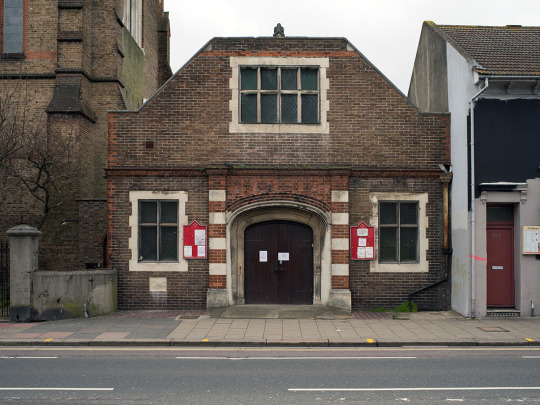
This is Wagner Memorial Hall named after Rev Arthur Wagner who commissioned the construction of adjacent St Bartholomew’s Church. This upset locals who complained that the excessive height of the building (as the tallest church in Britain) stopped their chimneys from drawing properly. Wagner bought all 400 neighbouring houses and subsequently reduced the rents.

The Extra Mural Cemetery next to Woodvale Crematorium is a sheltered, gently sloping, well wooded area of down land between two much steeper hills.... a good place for a walk.


The Bernard Oppenheimer Diamond Works was a diamond polishing factory built 100 years ago. It provided work and refuge for the majority of Brighton & Hove’s disabled war heroes, some of whom were amputees needing specialist treatment. Now the Big Yellow Self Storage, popular with local students often leaving for the summer before returning and renting different rooms.

The site of the former Preston Barracks which were builtin 1793 to sustain potential Napoleonic invasion after the French revolution. They were demolished in the 1990s and the site is now a University of Brighton student housing development.

Like the nearby more modern St. George’s hall in Moulsecoomb, halls like this one build in 1949 which were once community meeting grounds are now often left empty with staff blaming changing demographics in the community.

Behind this junction at the end of Queensdown Rd is Homewood College, a community special school. Accessible only by foot from Moulsecoomb Station are Brighton & Hove Pupil Referral Unit and Cedar Centre Special School. The absence of these schools in image was both an aesthetic and political decision, reflecting on the otherwise hidden nature of their geographical location.
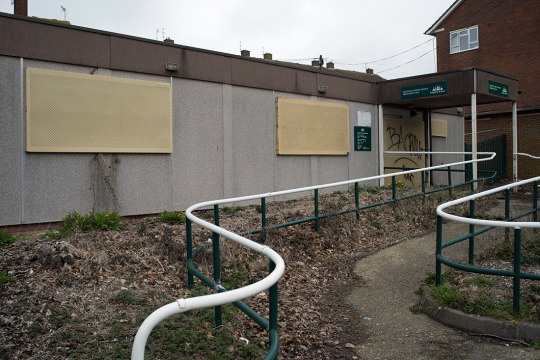
Since the mid-eighties, the twin phenomena of the Right to Buy scheme and the 1992 Universities Act have had the dual effect of displacing once established communities in these post-war housing estates as many residents have cashed-in and moved out creating increasing numbers of tenanted HMOs (houses of multiple occupancy) to cater for the increased influx of students from University of Brighton. Situated on Bates Estate noted for its high incidents of report crime, this housing office closed down in March 2014 due to a decline in the number of people using the office. Local residents have rejected plans for a new block of flats on the site. This is in spite of a similar development in neighbouring Whitehawk on the site of the old housing office. The scheme is known as New Homes for Neighbourhoods and is intended to provide much-needed affordable housing. Council bosses hope that a new block of flats could help lead to the regeneration of one of Brighton’s ‘most notorious estates’.

The Moulsecoomb scheme was in the form of a garden city with winding roads, large grass verges, and big gardens. It was intended to house veterans of the Great War; there were even tennis-courts provided in The Avenue. In South Moulsecoomb, the earliest buildings were effectively an adjunct to the existing housing opposite Preston barracks, but the later extensions of North and then East Moulsecoomb took the estate out into relatively remote countryside. The 478 houses were meant to provide new homes for people in the proposed slum clearance areas on Albion Hill, but the rents charged by the council were prohibitive for most of the intended residents, and tenants were brought in from other towns, especially London, following an advertising campaign. Little was therefore done to relieve the appalling conditions in central Brighton.

The mainline rail track between Falmer and Moulsecoomb stations running adjacent to these dilapidated garages separates the Bates Estate from the Home Farm Business Centre, home to American military weapons manufacturer EDO MBM Technology Ltd/Harris. The UK firm makes the EDO MBM Zero Retention Force Arming Unit, an electro mechanical device used on military aircraft bomb racks to arm munitions as they are released from the aircraft. The headquarters has been the target of multiple instances of anti-war activism.

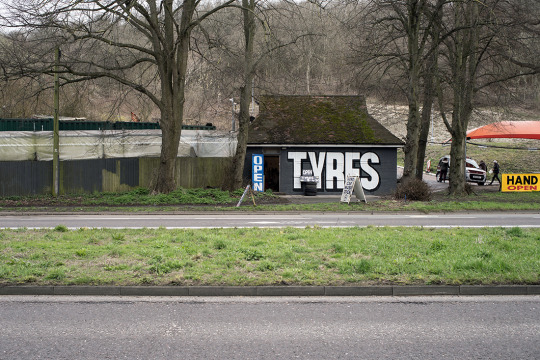
Anyone coming down Lewes Road from Falmer can’t miss Rory’s Hand Car Wash which backs on to Wild Park. Near the back of the park is what's known locally as the "ski slope" which rises to the Hollingbury Fort and gives views across the city. Wild Park will always be synonymous with the ‘Babes in the Wood’ murders in 1986 which remain unsolved.
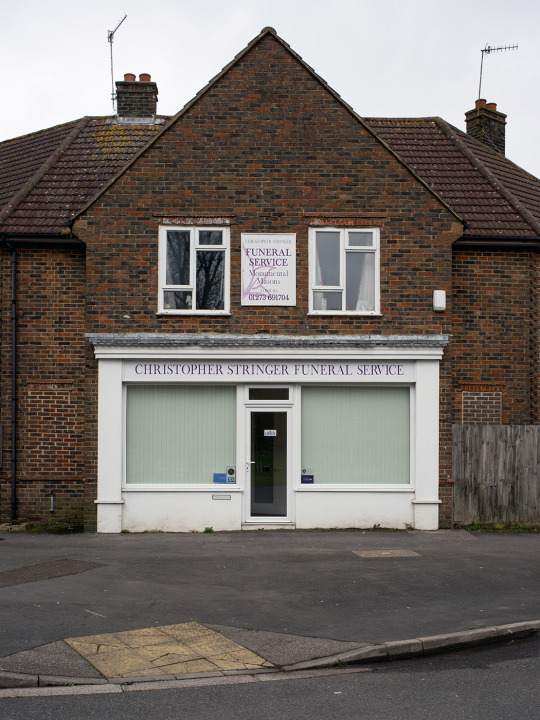
The Stringers have the monopoly of funeral services in the Lewes Road area and have been a staple of the community from Moulsecoomb down to the Level for decades, if not centuries.

This phone box appears like a grotesque tardis to some lost past. This one interestingly without a door, as if it would be too tempting a prospect for ‘scoombers’ to make varied use of a phone box with a door... city planning at its finest.

As well as housing students in HMOs, Barcombe Road is home to some local families, whose kids patrol on bikes haranging visitors to take pictures of them.




The entrance to 'The Keep', the East Sussex Record Office. A heterotopia of time... '...an unrivalled, detailed record of the region’s history, dating back over 900 years. These archives document the lives of individuals, places and events from across the county and beyond, and they include written records, maps and plans, prints and drawings, photographs and films, oral histories, and digital and electronic records.' (Source - thekeep.info)

The Keep serves as an artificial and psychological barrier between the Moulescoomb estates and the universities.

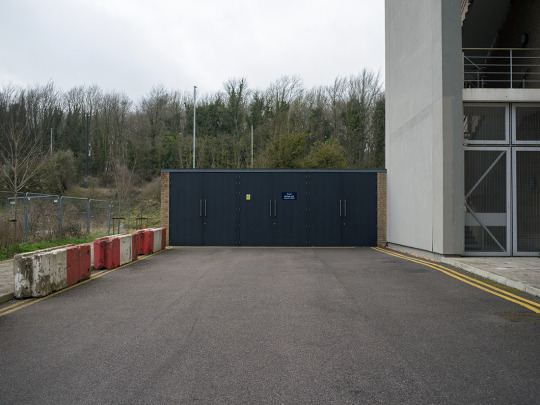

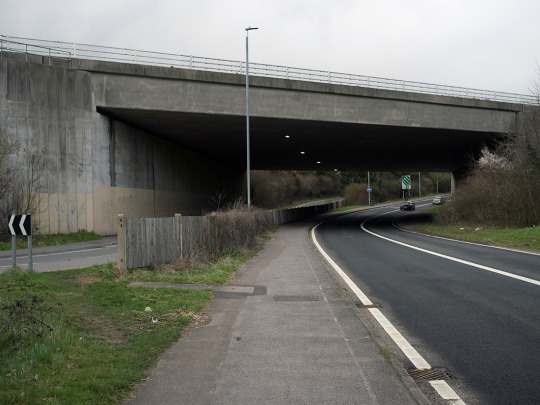
The end of Moulescoomb and the continuation of the A270 under the flyover. The next stop is HMP Lewes, home to many of Moulescoomb and Bevendean's convicted criminals.
#heterotopia#travelogue#journey#spatialinjustice#spatialjustice#lewes#brighton#photography#photographer on tumblr#social landscape#social documentary#estates#britain#england#psychogeography#derive#architecture#bland#urbex#urbandecay#urbanexploration#urbanphotography#urban#suburbia#subtopia#city planning#social housing#social horror#social history#weaponized
3 notes
·
View notes
Photo

Just Pinned to Newest Sewing Patterns: Vogue 1793 Dress by Marc Jacobs Size: 8-10-12 Uncut Sewing Pattern https://is.gd/YSROE6 #SewingPattern, #Vogue Pattern-Walk https://ift.tt/2nnOmF5
0 notes
Text
Law & Order

Un test politique a récemment été partagé et utilisé par un certain nombre de mes contacts Twitter. Il permettait de se positionner sur plusieurs axes en fonction d’un certain nombre de questions, et donnait des résultats assez visuels et amusants.
Néanmoins, l’une de ces questions en particulier m’a intéressée ; elle visait à déterminer le rapport à la loi. En substance, elle demandait : doit-on toujours effectuer une contestation sociale dans le respect de la loi ?
Cette question est plus complexe qu’il n’y parait. En effet, notre rapport individuel à la loi est généralement assez flou et changeant : certaines lois sont, en fonction de nos envies, des suggestions bien plus que des devoirs. Ainsi, qui peut dire n’avoir jamais, dans sa vie, traversé une rue sans attendre le passage au vert ?

Pour rentrer plus en profondeur dans le sujet, imaginons un cas précis. Vous êtes dans la rue, avec votre iPhone tout neuf qui a coûté un mois de SMIC. Je suis dans la même rue, et je n’ai pas d’iPhone tout neuf. Qu’est-ce qui m’empêche de prendre le vôtre ?
La réponse sera, bien entendu, “la loi”. C’est la loi qui créé le droit à la propriété, et donc qui fait que je ne peux pas prendre votre iPhone. Mais si vous décidez que la loi concernant les passages piétons est relative et peut être ignorée quand vous le souhaitez, qu’est-ce qui fait que je ne peux pas décider d’ignorer la loi sur la propriété quand je le souhaite ?
Instinctivement, nous sentons bien qu’il y a une différence entre les deux ; mais cette différence n’est pas simple à définir. Nous pourrions parler d’un droit fondamental - le droit à la propriété - mais le passage piéton participe du droit à la sécurité, pour vous et pour les automobilistes. Nous pourrions dire que c’est une loi universelle, mais l’interdiction de traverser au rouge est aussi globalement universelle actuellement. Nous pourrions nous appuyer sur l’histoire, mais le droit à la propriété a été changeant au fil du temps, en particulier en fonction du statut social du propriétaire.
Au final, il n’y a pas réellement de réponse satisfaisante, si ce n’est une : le concept de victime. Si une personne traverse au rouge, il n’y a pas de victime. Si je prends votre iPhone, il y en a une, vous.
Cette notion de crime sans victime peut néanmoins être facilement remise en cause, de manière multiple. Ainsi, la voiture qui devra s’arrêter ou ralentir parce que vous avez traversé au rouge, n’est-elle pas la victime de vôtre action ?
Un cas particulièrement frappant de “crime sans victime”, c’est l’histoire du lancer de nain. Le lancer de nain, c’est un “sport” pratiqué en bar ou discothèque, particulièrement en vogue à la fin des années 80 ; unæ nainæ (volontaire), habillæ d’un casque et d’une tenue rembourré, était lancæ le plus loin possible, læ gagnantæ étant cellui qui læ lançait le plus loin. Cette pratique est encore légale en France, mais a été interdite par certains maires à partir de 1991 ; après des attaques en justice conduites par un nain et son employeur contre ces interdiction, il a été conclu par le conseil d’état que celles-ci étaient légales, car l’activité était “contraire à la dignité de la personne humaine et troublait l’ordre public”.
Nous avons donc ici un cas frappant de crime “sans victime” : la victime est en fait l’image et la conception que nous nous faisons de l’humain et de ce qui peut ou non être fait - et du handicap. Par extension, nous pourrions dire que le fait de traverser au rouge a pour victime notre conception de la loi et de l’ordre social.
Ainsi, nous voyons qu’il n’existe pas réellement de “crime sans victime”. Il devient donc impossible de séparer les lois “que nous devons suivre” et celles “ignorables” : la seule solution serait-elle, alors, de toujours respecter la loi ?

Nous avons pour le moment pris l’exemple de deux lois “générales”, c’est à dire qu’on peut retrouver dans la plupart des pays du monde. Mais la loi est avant tout un outil. Ce n’est pas un absolu qui proviendrait d’un monde idéal, une abstraction qui s’incarnerait sur Terre pour nous donner des consignes sans failles. C’est un texte, écrit par des humainæs ; et comme tou·te·s les humainæs, iels ont leurs propres motivations.
La loi vise en pratique à imposer un modèle de société. Certaines parties de ce modèle nous sont communes : nous nous retrouvons ainsi généralement dans l’interdiction du meurtre, du vol, du viol. Peu de gens vont ouvertement dire “il devrait être autorisé pour tout le monde de tuer les autres si iels ne sont pas d’accord”.
Mais certains autres éléments sont des questions intrinsèquement liées à notre vision du monde : la peine de mort, par exemple, est en fait une question tournant autour de notre propre conception de l’humanité.
Cela implique également que la loi peut être détournée. Ainsi, les lois légitimant l’apartheid dans les (nombreux) pays l’ayant pratiqué visaient en pratique à assurer une séparation de classe et la survie d’un système dominant / dominé basé sur la couleur de peau.
Ce type de loi, qui vise à instaurer et maintenir une inégalité sociale, est généralement auto-entretenue : la loi est écrite et validée par les dominantæs, et elleux seulæs ont le pouvoir de la défaire ; et la loi met en place des obstacles suffisants pour que les dominæs ne puissent ré-écrire cette loi.
Les situations de domination de ce type sont nombreuses et existent encore ; et les détournements de la loi sont toujours monnaie courante. Un exemple récent est la limitation du cortège contre la loi Travail à une portion congrue, par application de la loi : le but était de maintenir la situation de dominance des riches en réduisant la visibilité de la contestation.
La disparition de ces inégalités ne peut se faire en respectant ces lois : l’abolition de l’esclavage et de l’apartheid en est un excellent exemple. Jamais une inégalité sociale profonde et entérinée par la loi ne s’est effacée sereinement. Il y a une certaine logique à cela : les dominantæs sont les seulæs à pouvoir le faire, et n’ont rien à y gagner.
Alors, à nouveau, se pose la question : comment choisir quand respecter ou non la loi ? L’article 35 de la constitution du 24 juin 1793 (constitution de la première république) peut nous donner une piste de réponse :
Quand le gouvernement viole les droits du peuple, l’insurrection est, pour le peuple et pour chaque portion du peuple, le plus sacré des droits et le plus indispensable des devoirs.
2 notes
·
View notes
Photo



IM IN LOVE WITH THIS WOMAN😍❤ Im such a fanboy. I love to draw MARIE ANTOINETTE thus watching Sophia Coppola's 2006 movie. This movie introduced me to this amazing but tragic historical figure which I then read and researched about. I am 100% aware that the proportions of the face are still off. I am trying to match Kirsten Dunst's facial features. Isn't Kirsten pretty? In my opinion, she did an amazing portrayal of the last queen of France. I know some people may see this woman as a selfish and ambitious whore. And you are right from a certain point of view. (#starwarsreference) But I personally believe that of the young teen queen there can be said as many bad things as good things.👍👎🖒🖓 GET READY CAUSE IM GONNA TRY TO TELL YOU THE STORY OF MARIE ANTOINETTE IN CASE YOU WANT TO KNOW A BIT MORE. 2 November 1755 The Archduchess of Austria Marie Antoinette is born. Her life was planned out from birth. Her mother the empress Maria Theresa had in total 16 children which she planned to marry with important royals all over Europe. Young Marie Antoinette was to become queen of France thus marrying the dauphin (hier to the throne) of France Louis. Then she would become the dauphine. Antoinette married with only 15 years of age and felt knew to the foreign court of France. It was so different and so strange. She was to follow a strict protocol. What was extremely worrying, was that she and young Louis had to bring a hier to the throne. If not, nothing was certain. She didn't have full power over anyone without a hier. Her mother was extremely strict with this matter and would send her letters to explain how worried she was. However, there wasn't a young son until 7 years later. Soon Louis XV the father of Antoinettes husband and former king of France died leaving young Louis and Marie to the throne. At 18, she became queen of France and Louis became king Louis XVI. The Marie Antoinette had power. She became the "teen queen that rocked Versailles" as said by the Vogue magazine. She had close friends like the Duchess of Polignac and the Princess of Lamballe. Marie Antoinette was mainly known for eating a lot of cake and candy. And she did. She spent a lot of money on cakes and drinks for neverending parties; dresses, wigs and shoes. She "spent France into ruin". This was one of the things the french people said of her. While she was quite popular at Versailles, she was hated by the majority of the country. Louis XVI gave Marie Antoinette the Petit Trianon. A small little villa similar to Versailles. She would invite whoever she wanted breaking the protocol of who was more important and rightful at versailles. She became unpopular at versailles too and people began to rumor about orgies at petit trianon. She was named Madame Deficit and the Austrian Ostritch. The french revolution grew with a law that broke the priviliges. Marie Antoinette tried to reduce her waste but it was too late. The royals had to move out of Versailles to a safer place leaving Marie Antoinette marginated. Soon the royal family had to move too. They were caught and put on trial. Louis was executed the 21 January 1793 Marie Antoinette was executed the 16 October 1793 Thats the story. Im sorry if I wasnt clear enough. Just know I feel respect for rhis woman. Watch the movie its great.😍😍😍
5 notes
·
View notes
Text
Vogue 1793: Caroline Penvenen’s Riding Habit

Caroline in the books was always the most fashion forward out of all of the female characters, and her S2 wardrobe confirms that essential part of her personality. (Photo from Far Far Away)
Caroline’s jacket and petticoat combo is called a riding habit or redingote. Upper class women wore riding habits for side saddle horseback riding as well as for general daytime or traveling. Fashion historians have documented how the riding habit evolved from attempts to feminize men’s fashions of the time. Pants were out of the question, so petticoats were restyled into something effective for riding and other physical activities.
I believe Caroline’s outfit might be a creative copy of this famous painting of Lady Seymour Worlsley. The only thing missing are the military jacket-esque trimming. This article on the Georgian Era blog dives into more detail about the background on the painting.

Riding habits were usually made out of wool or blended wool. There are some examples of riding habits made out of silk such as some of the museum pieces in this post by The Closet Historian. Some were uniform in color while others favored contrasts between the jacket and skirt.
For the Outlander fans who were thinking that Caroline’s riding habit brings back memories of Claire’s black and white jacket and skirt from Paris, you’re on the right track! The riding habit trend is exactly what Terry Dresbach was tapping into.
Do you have any more Caroline costume questions? Here’s the Ask Box!
#poldark#caroline penvenen#poldark costumes#poldark costuming project: caroline#18th century clothing
36 notes
·
View notes
Photo
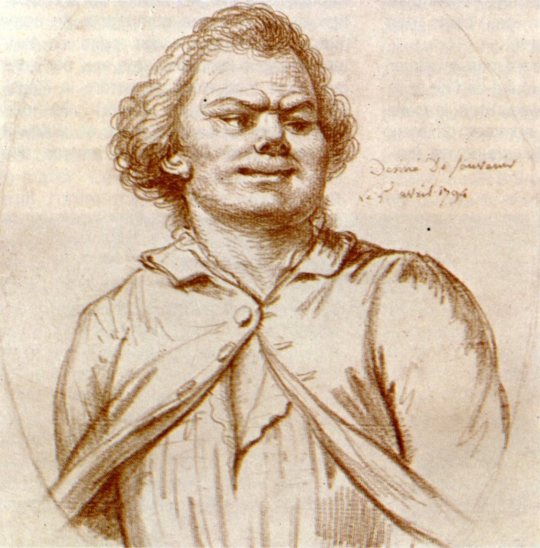
Danton and the terminology of the « terror » (Annie Jourdan)
If, in historiography, Danton does not embody the Terror, he nevertheless pronounced the term and its derivations. There is nothing original about this. From the beginnings of the Revolution onwards, the contemporaries were particularly fond of this word in order to describe the fear that was felt and the reply or reaction which imposed itself. And this not only applied to France. In London, for example, it was the government which threw « a great terror among all friends of the French nation ». In Paris, the Girondin Lasource complained that the inaction of the French armies in May 1792 was such that « one will [never] inspire terror to our enemies ». Browsing the pages of the Moniteur universel, one will discover the diverse usages that were in vogue at the time. Divine terror, judiciary terror, military terror or the terror that is proper to despotism. Gustav III, the king of Sweden, assassinated in March 1792, thus only owed his successes to the terror which he inspired. His brutal death, however, proved that « the terror is not the safeguard of the princes ». The petition of 17 June 1792, presented by the section of Croix-Rouge, demonstrates well that « terrorist » speech could be diverted and harnessed by another cause, as it proposed to « transfer the terror into the soul of the conspirators ». What is particularly new here – as in Danton's speeches – is that it is not God, the prince or the judge would inspire terror, but the people – through its sections, its legions or its representatives. This usage would become popular in the course of the Revolution and produce the expression « the terror is the order of the day ». Being a « magic » formula in a way, conceived in August 1793 in order to appease the popular sections, it would be used by various revolutionaries en mission or by some deputies at the tribune of the Assembly, in order to designate the inflexible policy that was established from this date onwards, while it was never officially proclaimed by the Convention. On 5 September 1793, in fact, it was not the terror that was decreed, but the creation of a revolutionary army. It was it, and it alone, that would carry the terror into the insurrectionary departments. This is also what results from Barère's speech, while the decree of the same day did not refer to said terror at all, when it ordered that « the revolutionary army will execute, everywhere where it will be needed, the revolutionary laws and the measures of public safety ». Concentrating on this formula too much can thus lead to an error. This does not mean that synonymous or derivative terms have not been frequently invoked in order to invite to action, to designate the measures that were taken or to be taken, to sanction committed acts and to frighten the enemies. One will see that it is justly in the mouth of Danton that these are most recurrent. The rule of conduct of the Convention wanted to be very different, as the decree of 2 Germinal Year II (22 March 1794) demonstrates, which proclaims that justice and probity are the order of the day. And this is understandable. The dignity of France and the legitimacy of the Revolution was at stake. Fighting against the counter-revolution could not be done to the cost of either of them.
Terroriste avant‑la‑lettre ou terroriste à temps partiel ? (Annie Jourdan), in Danton: le mythe et l’Histoire (Michel Biard & Hervé Leuwers)
17 notes
·
View notes